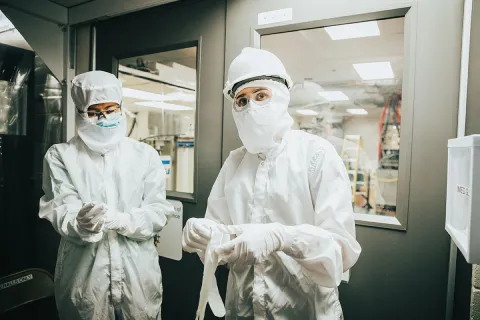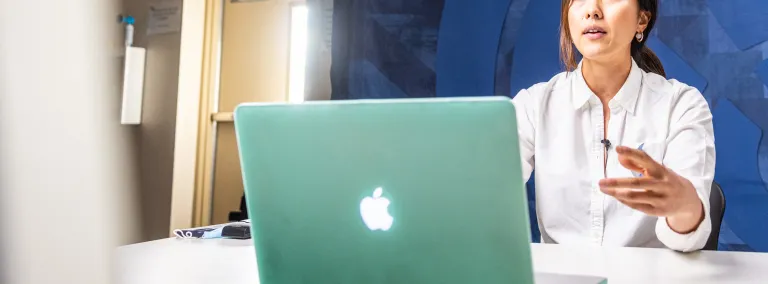Q&A with Leekyung Kang, SURF Artist-in-Residence
Learn about how Kang hopes her audience experiences her work and how she seeks to re-envision scientific concepts through art
To artist Leekyung Kang, every landscape is stratified with physical, invented and imagined layers. Inspiration for her artwork stems from these layered landscapes: construction sites in Seoul, South Korea; the brittle materiality and brutal heat of the Qatar desert; the peculiar slant of windows in Rhode Island’s historic buildings; and, more recently, the undulating waves of Lake Michigan.
This year, the Sanford Underground Research Facility (SURF) invited Kang to explore the singular landscape of a sprawling mine turned cutting-edge research facility as the 2021 SURF Artist in Residence (AiR).

Kang explored the underground drifts and laboratory spaces at SURF and spoke with scientists about their research. We spoke with Kang about her teaching approach, how she hopes her audience will experience her work and how she seeks to re-envision scientific concepts through art.
In anticipation of her upcoming exhibit, "Ongoing Up-ending," inspired by SURF, we are sharing portions of our conversation with Kang. The interview has been edited and condensed for clarity.
SURF: How do hope your audience will interact with your artwork?
Kang: We’re living in the era of the internet and the digital space. Everything is fast. And we tend to forget about things that we should consider more seriously. How do we perceive the world? How do we understand what we do? What are we supposed to do as human beings?
When we're just living, doing what we need to do in everyday life. Sometimes you have one of these questions, but you tend to move on, to forget what the question was.
When people see my art, I want them to think of those questions. I want the art to remind them of their curiosity, of the questions they had.
I don't think I can make an answer. But I could help them understand something a bit better, and I can even make things more complicated. As an artist, I am communicating with people. We are asking questions of each other, creating a field of communication. I think that is the function of art in this time.
SURF: What’s your approach to teaching art?
Kang: When I teach classes, I encourage my students to explore different mediums as much as they can. If they're just painting, then that could be limiting for them as they try to express or visualize their art. I want them to at least understand every medium so that they could have access. After they experiment, then they can narrow down.
Another thing I recommend for students is that they learn digital languages. In their generation, they have a responsibility to understanding the skills and trends that aren’t going away.
I personally enjoy digital work. My digital practice makes it easy for me to capture fragments of reality. It's a kind of circulation: taking a photo from a real space, from the camera to the computer, where I manipulate and edit, and then I print and make it part of a physical exhibit, and then it's real again. I like to have that kind of circulation in my practice.
SURF: What are you experimenting with in your practice right now?
Kang: Printmaking is a very traditional methodology; it goes back even to Gutenberg’s letter press. But now, we’re using computers, smartphones—the digital interface all the time. We just click “copy” and “paste.” That is the contemporary version of printmaking. It’s a very easy and useful way for us to understand the world of image and prints.
I’m trying to redefine the practice of printmaking, from a traditional medium to non-traditional medium. How do we understand the concepts of printmaking? How do I bring that idea to the art world? How do I communicate that to people? Those are the questions I’m asking right now.
SURF: In your experience, how do science and art overlap?
Kang: Science and art—we have a lot of similarity and commonality. In both fields, you’re trying to solve a very abstract problem. Especially at SURF—looking at dark matter and neutrinos—these are unresolved areas where we're trying really hard to figure things out. And as they figure it out, there’s a new problem of getting others to understand their research.
That process, of manifesting and visualizing abstract ideas, is very interesting for me.
As an artist, I can make things a little bit clearer. I can help people understand things better. I can think of ways to visualize complicated science concepts, like dark matter, and recreate it in a visual form to communicate those ideas with other people.
SURF: What do you hope to achieve through your residency at a science laboratory?
Kang: Preparing for this residency, I watched some documentaries about dark matter. From my perspective, the scientific illustrations in those documentaries look similar to what I’ve seen in textbooks, in videos, in other education materials since I was young. Those illustrations are helpful for me to understand the theory. But at the same time, I've seen those images 100 times already.
I understand why they’ve made the illustrations the same way for so long. They had to be very informative. Very correct. People need to understand the scientific theory.
But as an artist, I think I need to break that idea. We were taught that that’s the way you are supposed to understand it. But what if that’s not the only way to understand it? With my exhibit, I want to break those molds.
